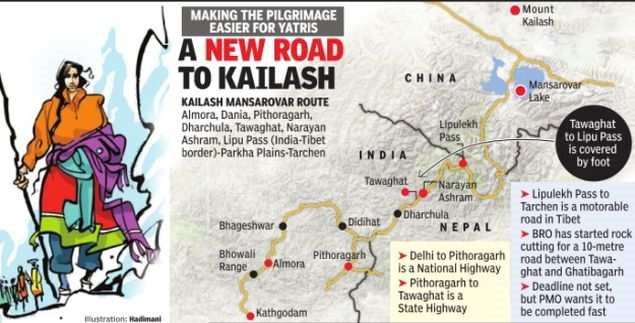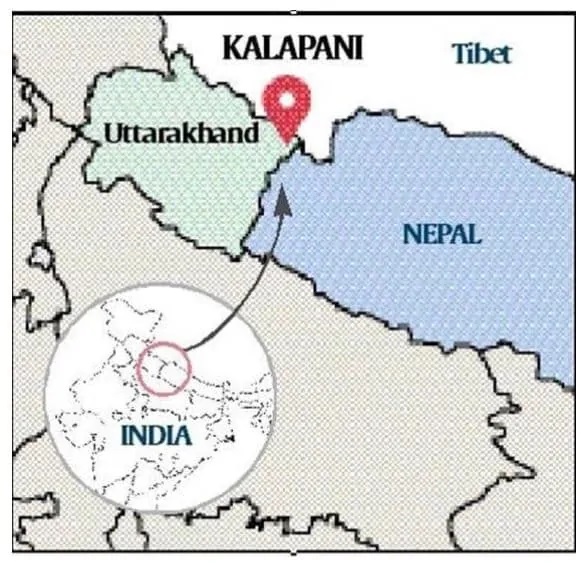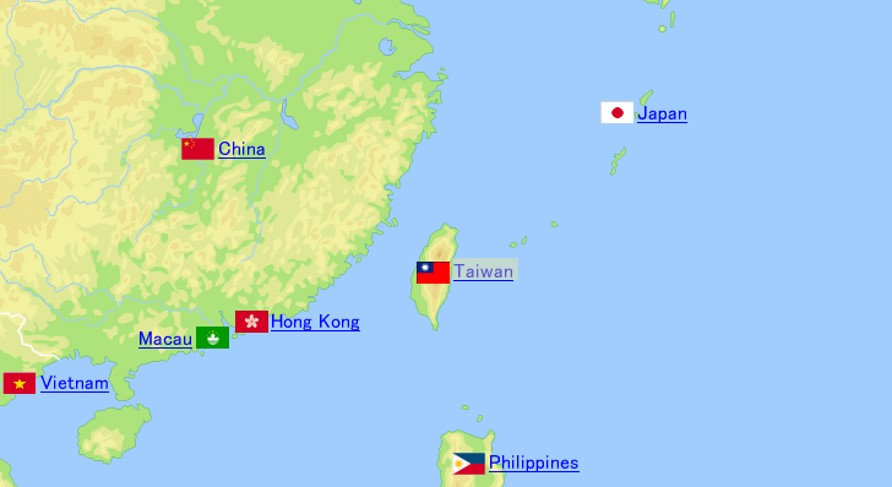Contents
- Getting India back to the Afghan high table
- The new Indian road to Lipu Lekh, Explained
- The Taiwan question
GETTING INDIA BACK TO THE AFGHAN HIGH TABLE
Focus: GS-II International Relations
Introduction
An Election result that was rejected by Mr. Ghani’s main rival, Abdullah Abdullah led to two simultaneous swearing-ins; both Mr. Ghani and Mr. Abdullah taking oath as President.
It is true that the international community ultimately supported Mr. Ghani but qualified it with an insistence that he enters into a real power-sharing agreement with Mr. Abdullah which just been reached.
India’s exclusion
- The United Nations Secretariat organised a meeting on Afghanistan where it invited the six current physical neighbours of Afghanistan—China, Pakistan, Iran, Turkmenistan, Uzbekistan and Tajikistan.
- In addition, invitations were extended to the United States, Russia and the Ghani government, however, India was not invited.
- Hence, the constructive role New Delhi has played in Afghanistan’s reconstruction since the Taliban were ousted from the country in 2001-2002 after 9/11 did not mean India will get an invitation.
- The U.S. also went along with India’s Exclusion.
- It has been noted that despite India’s contributions to Afghanistan’s economic development — and these are undeniably significant covering large parts of the country, and are popular — as well as its long history of contacts with that country, it does not have a place in international diplomacy on Afghanistan.
- India’s presence was quite significant because Afghanistan impacts on India’s interests, especially its security concerns are crucial.
- It can also be said that by avoiding open contacts with the Taliban, India has reduced its role in international diplomatic efforts.
- One side of the argument supporting direct Indian conversation with Taliban is: Contacts and discussions do not mean acceptance of their ways or that their professions of not being Pakistan’s stooges should not have been tested.
Other things at play
That the U.S. is currently crucially dependent on Pakistan for the successful implementation of its Taliban deal aimed at securing as orderly a withdrawal as possible from what is a major strategic reverse for the world’s pre-eminent power is not in doubt.
Echo from the past
- It is sad that despite all that India has done in Afghanistan over the past 18 years since the Taliban were ousted from Kabul in 2001, it finds itself on the margins of international diplomacy on Afghanistan.
- It is reminiscent of the time in the 1990s when, at Pakistan’s insistence, India was considered a problem and kept out of crucial global forums on Afghanistan.
-Source: The Hindu
THE NEW INDIAN ROAD TO LIPU LEKH, EXPLAINED
Focus: GS-II International Relations
Why in news?
India, on May 8th, inaugurated an 80 km road goes right up to the Lipu Lekh pass on the LAC, through which Kailash Mansarovar pilgrims exit India into China to reach the mountain and lake revered as the abode of Siva.
Nepal protested and has also pointed out that it has brought up its concerns on the border issue several times, including in November 2019, when Delhi put out its new political map of India to show the bifurcation of Jammu-Kashmir.

Usefulness of the road
- The road is on the route of the annual Kailash Masarovar Yatra, which goes through Uttarakhand’s Pithoragath district.
- The road is built by the Border Roads Organisation (BRO)and is important for “strategic, religious and trade” reasons.
- What used to be a difficult trek for the pilgrims to the gateway, situtated at 17,060 ft, would now be an easy road trip.
- The new road is also expected to provide better connectivity to Indian traders for the India-China border trade at the Lipu Lekh pass between June and September every summer.
Complications around building the road
- Building roads leading to the contested LAC with China has been a fraught exercise for the government.
- It was only in the wake of the 70-day Doklam stand-off with China in 2017, that India realised with shock that most of those roads had remained on the drawing board.
- A report submitted by a standing committee flags the India China Border Roads (ICBRs) as a crucial element in “effective border management, security and development of infrastructure in inaccessible areas adjoining the China Border”.
Nepal’s Objection
- Army Chief General said on May 15th that Nepal’s protest was at “someone else’s behest”.
- His statement has been widely taken to mean that Nepal was acting as a proxy for China.
- Kathmandu has pointed out that it has brought up its concerns on the border issue several times, including in November 2019, when Delhi put out its new political map of India to show the bifurcation of Jammu & Kashmir.
- Nepal’s objection then was the inclusion of Kalapani in the map, in which it is shown as part of Uttarakhand. The Kalapani area falls in the trijunction between India, China and Nepal.
- The Nepal government described India’s decision as “unilateral” and claimed that it would “defend its international border”, while the Ministry of External Affairs then said that map “accurately reflects the sovereign territory of India”.
Resolving Nepal-India Border issues
- The Nepal-India border was delineated by the Sugauli Treaty of 1816, under which it renounced all territory to the west of the river Kali, also known as the Mahakali or the Sarada river. The river effectively became the boundary.
- In the 1980s, the two sides set up the Joint Technical Level Boundary Working Group to delineate the boundary, which demarcated everything except Kalapani and the other problem area in Susta.
- In 2000, both sides agreed to demarcate the outstanding areas by 2002, which has not happened yet.
The Kalapani Issue Explained

- Nepal’s case is that the river originates from a stream at Limpiyadhura, north-west of Lipu Lekh. Thus Kalapani, and Limpiyadhura, and Lipu Lekh, fall to the east of the river and are part of Nepal’s Far West province in the district of Dharchula.
- New Delhi’s position is that the Kali originates in springs well below the pass, and that while the Treaty does not demarcate the area north of these springs, administrative and revenue records going back to the nineteenth century show that Kalapani was on the Indian side, and counted as part of Pithoragarh district, now in Uttarakhand.
China’s Role
- Since the 1962 war with China, India has deployed the ITBP at Kalapani, which is advantageously located at a height of over 20,000 ft and serves as an observation post for that area.
- Nepal calls it an encroachment by the Indian security forces.
- Nepal has also been unhappy about the China-India trading post at Lipu Lekh, the earliest to be established between the two countries.
- A year later, during the Doklam crisis, a senior official in the Chinese Foreign Ministry raised temperatures by suggesting that India would not be able to do anything if the PLA decided to walk in “through Kalapani or into Kashmir, through PoK”, both trijunctions like Doklam.
- Though China has said nothing about the road construction to Lipu Lekh, it has protested similar road building activity at other places on the Indian side close to the LAC, including Ladakh.
Conclusion
In view of all this, Kalapani and the approach to Lipu Lekh has only grown in strategic importance for India, especially as relations between the two countries have remained uneven over the last few years, and China has upped its game for influence in India’a neighbourhood.
-Source: Indian Express
THE TAIWAN QUESTION
Focus: GS-II International Relations
Introduction
- As the World Health Assembly (WHA) convenes in the 4th week of May, virtually, there is a political battle over the question of inviting Taiwan to join the discussion as an observer.
- The Assembly brings together the ministers from all the member-states of the World Health Organisation.
The Arguments for Taiwan
- Proponents point to Taiwan’s success in dealing with the coronavirus and its role in contributing to international cooperation against the COVID challenge.
- Taiwan points to the fact that it had participated in WHO meetings from 2009 to 2016.
- Taiwan argues that the WHO should be focused on promoting global health and it should not exclude an important territorial entity on political considerations.
China’s Arguments against Taiwan
China has been adamant in its refusal to let Taiwan attend the meeting and Chinese position on Taiwan’s participation in the WHO deliberations have intensified after a pro-independence party was elected to power in 2016.

India’s Position
- India is all set to be elected as the chairman of the executive board of the WHO in the 4th Week of May, for the next three years.
- Taiwan’s participation is likely to come up for discussion at the WHA.
- Many of India’s partners, including the US, Japan, Australia, New Zealand, with whom Delhi has been actively coordinating its international response to the COVID crisis, are calling for Taiwan’s presence in the WHO deliberations.
- Both India’s Western partners as well as Beijing are said to be pressing India to support their respective positions.
Way Forward: Handling China
- Supporting Taiwan’s presence can be retaliation to China’s efforts against India, such as Repeated Chinese efforts in the months, after India repealed Article 370, to get the United Nations Security Council to discuss the Kashmir question.
- When the bilateral relations are going through a difficult phase and military tensions on the border are rising, there is also the danger of upsetting China.
- Delhi has never recognised Taiwan as a separate nation and there is no basis for conflating Taipei’s presence as observer at WHO proceedings with India’s consistent “One China” policy.
- At the same time, Delhi can’t afford to cede to Beijing a veto over its approach to multilateral issues.
- One such suggestion for a sensible middle path for India would lie in the apolitical appreciation of the specific technical issues involved and an objective merit-based decision.
-Source: Indian Express




